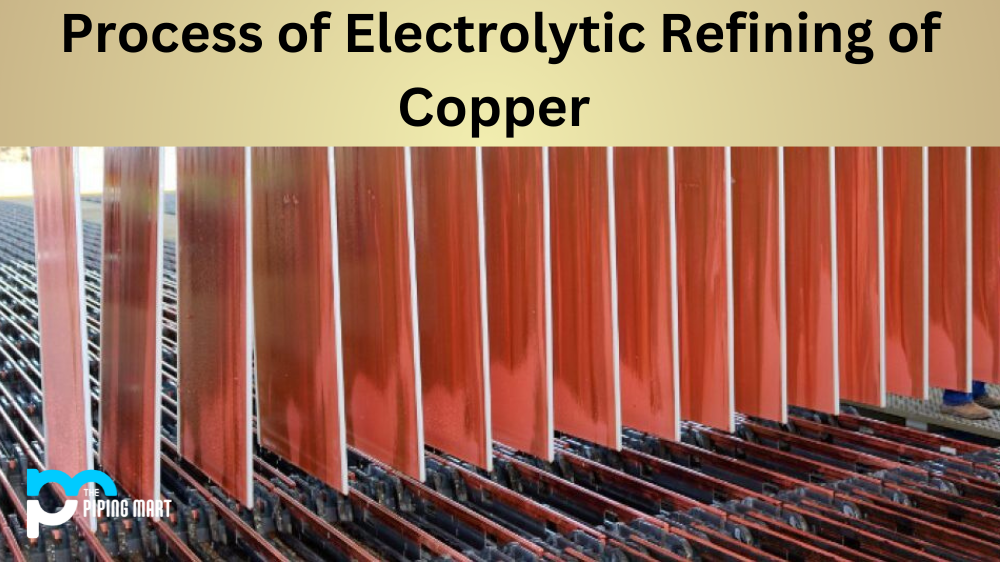Copper is a metal that has been used for thousands of years in many applications. It is still one of the most widely used metals today. In order for copper to be useful, however, it must first undergo a process known as electrolytic refining. This process can produce extremely pure forms of copper, far beyond what traditional smelting methods are able to achieve. Let’s take a look at how electrolytic refining works.
Electrolytic Refining
Electrolytic refining is a process that takes place in an electrolyte bath, which consists primarily of sulfuric acid and copper sulfate solution. An anode, made from pure copper, is placed into the bath, and a current is passed through it. The anode becomes the cathode, while the impure copper becomes the anode. As the current passes through the bath, impurities from the copper are drawn out and deposited on the cathode, while pure copper remains in solution as ions until it is deposited on the cathode.
At this point, there are two layers on top of each other; one layer consists of pure copper, and the other contains all of the impurities that have been drawn out during processing. The upper layer (the purer form) is then removed and melted down into bars or billets for further use or processing into other products, such as wires or rods. Meanwhile, the lower layer (the impure form) is recycled back into another batch of electrolyte bath to go through the same process again until all impurities have been removed from it.
Electrolytic Refining of copper process
The electrolytic refining process starts with a block of pure copper, known as an anode, which is placed into a tank filled with an electrolyte solution. The electrolyte solution contains sulfuric acid, which helps to carry the electrical current needed for the refining process. An electric current is then passed through the solution and onto the anode, which causes the oxidation of some of the impurities in the copper and leaves behind purer copper. This purer form of copper is then collected on another block called a cathode. After several rounds of this process, 99% pure copper can be achieved.
The purification process doesn’t end there though – any remaining impurities still need to be removed from the newly formed cakes before they can be utilized further. This can be done by leaching with sulfuric acid or nitric acid or by electroplating with zinc or nickel-based alloys. After these processes have been completed, you will have some of the highest quality purest copper available on the market today!
Electrolytic refining of copper
- Copper is a valuable metal that is used in a variety of applications.
- Electrolytic refining is a process that is used to purify copper.
- In electrolytic refining, an electrolyte solution is used to purify the copper.
- The impurities in the copper are attracted to the anode, while the pure copper is attracted to the cathode.
- The impurities are then removed from the anode and the pure copper is collected at the cathode.
- Electrolytic refining is a highly efficient process that can produce very pure copper.
Benefits Of Electrolytic Refining
Electrolytic refining offers a number of advantages over traditional smelting processes when used to refine metals like copper – specifically regarding purity levels and cost-efficiency. For example, electrolysis can produce up to 99% purity levels with minimal energy input compared to traditional smelting methods, which require much more energy input but only produce around 95% purity levels at best. Additionally, since this method does not require any additional materials beyond those already present in its environment (namely sulfuric acid), its costs can be kept relatively low compared to other methods, which require additional chemicals or materials to work properly.
Another major benefit of electrolytic refining is that it can easily separate impurities from precious metals such as gold and silver without having to resort to potentially damaging physical processes such as hammering or smelting. In addition, because no heat is involved in this process, there is no risk of damage to delicate stones when recovering valuable metals from ore or compounds containing them. Finally, since only pure metal deposits onto the cathode while impurities remain trapped at the anode during this process, there are no hazardous byproducts created during electrolysis that could potentially contaminate nearby water sources or air quality either directly or indirectly via runoff when using this method for refining metals.
Conclusion
Electrolytic refining has become increasingly popular in recent years due to its ability to create extremely high purities levels with minimal energy inputs required compared to traditional smelting processes like induction furnaces or arc furnaces which require much more energy input but don’t produce purities levels nearly as high as those available using electrolysis baths and equipment. Not only can this method save money by reducing energy costs but also by eliminating any need for additional materials beyond those already present in its environment – making it an ideal choice for anyone looking for maximum efficiency when extracting pure forms of metals like copper from their base elements or compounds! Thanks to electrolysis refining, we now have access to ultra-pure forms of metals that were previously impossible before this technology was developed!

Pipingmart is B2B portal specializes in industrial, metal and piping products. Also, share latest information and news related to products, materials and different types grades to help business dealing in this industry.




